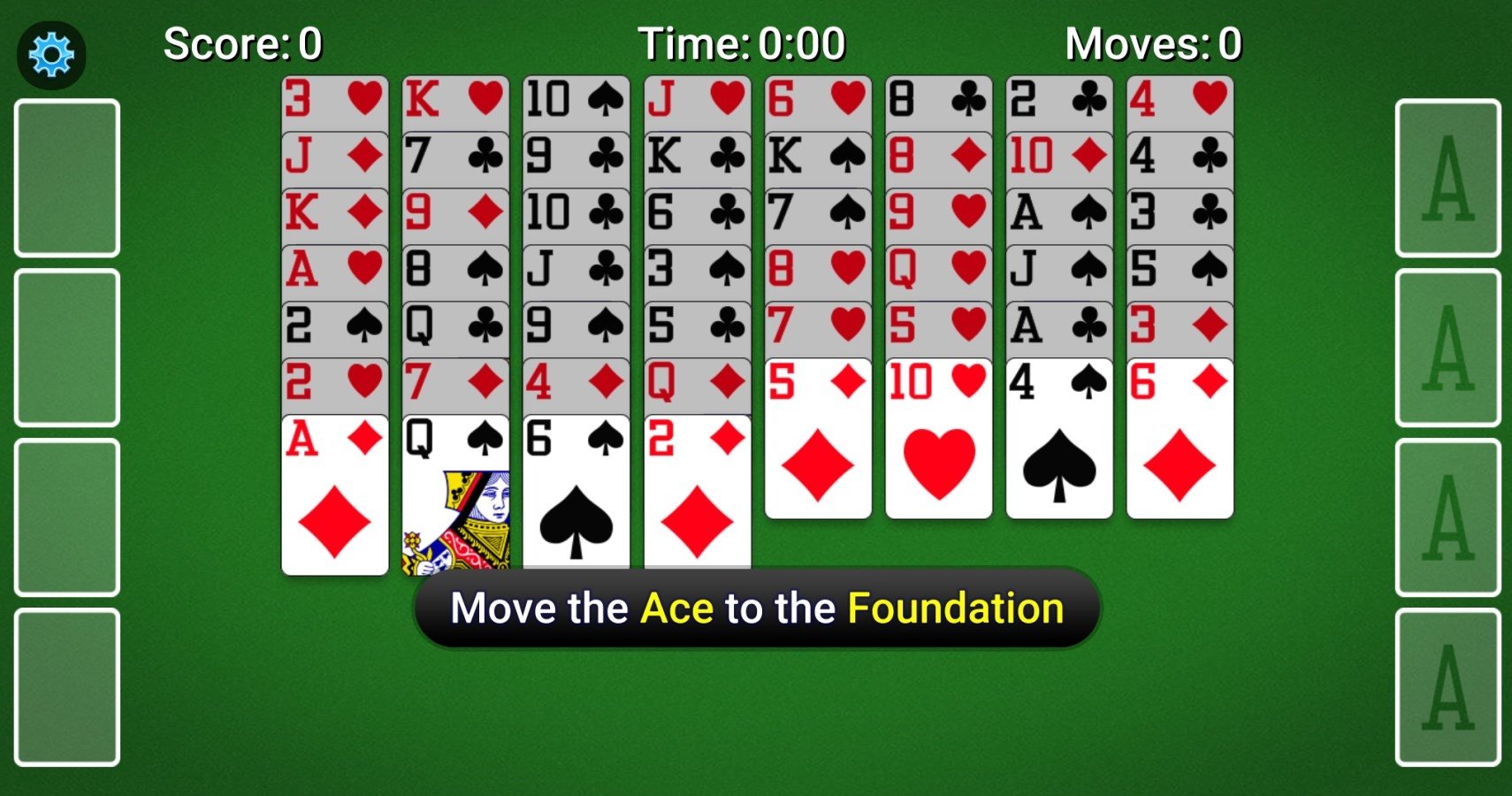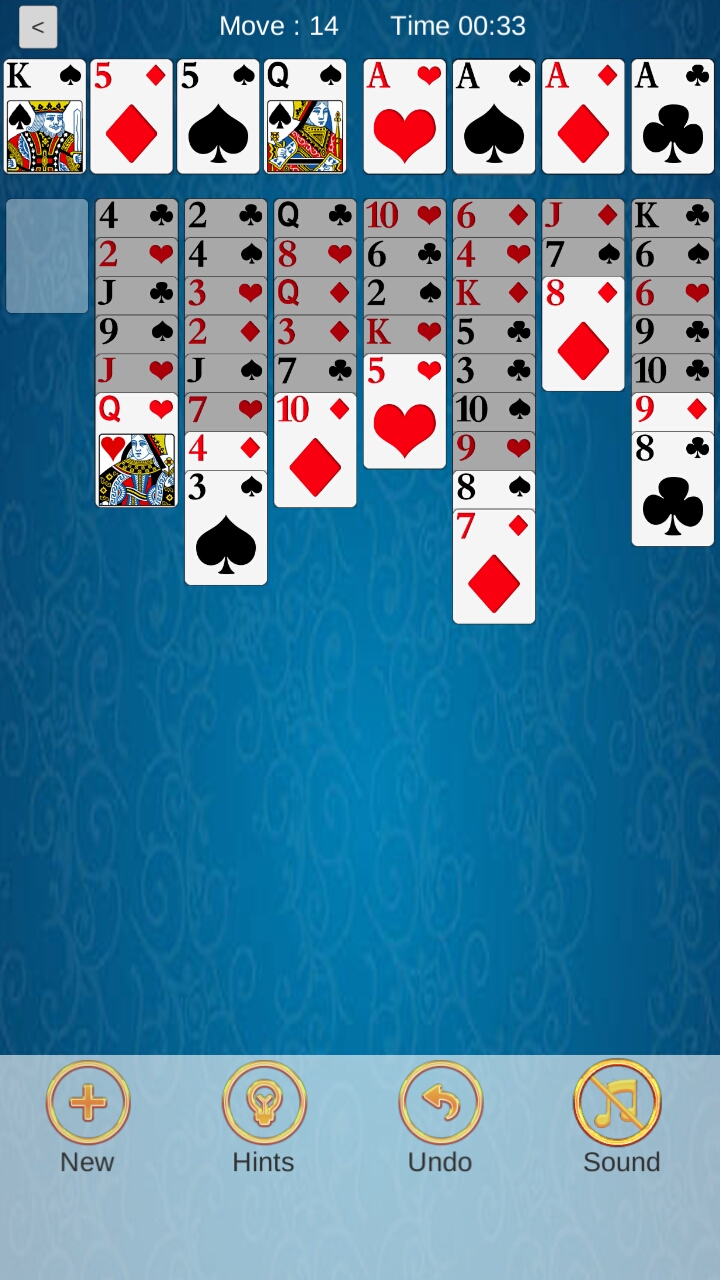Freecell Solitaire


- ›
- ›
FreeCell game info
Freecell is one of the most popular solitaire card games in the world. Like in Klondike Solitaire (a.k.a. Classic Solitaire) you're attempting to build up 4 suit piles called the foundations from Ace to King by suit. You have 8 columns on the lower part of the game screen known as the tableau.You can move cards between the columns to build them down from King to Ace. FreeCell Solitaire. Oct 31, 2019 by MiMo Games. 4.1 out of 5 stars 33. App Free Download. Available instantly on compatible devices. Classic FreeCell HD. Freecell Solitaire is a full screen classic solitaire card game. Just like in kondike solitaire, build stacks of cards in descending order and opposite color (red or black). You can drag-and-drop any card into one of the four 'free' cells on the top left, but always try to have an exit-strategy for that card.
FreeCell is a solitaire card game with all cards visible at the start of the game, which makes it quite unique compared to other solitaire games.
- Family: FreeCell Solitaire Games
- Decks: One deck (52 cards)
- Game time: Medium
- Chance of winning: High
How to play FreeCell
Table of contents
Goal
The goal in FreeCell is to move all cards from the tableau to the foundation, making use of the four free cells (also called reserve) that you can use as temporary storage. The foundations should be built up within the same suit and in ascending order, starting from Ace up to King. To win the game, all cards should be removed from the tableau.
Layout & deal
All cards from one deck (52 cards in total) are dealt face-up into eight tableau piles. The four leftmost tableau piles each have seven cards, while the four rightmost tableau piles each have six cards. There are four free cells (top left) and four foundation piles (top right).
The deals are random, except if you pick a numbered deal. This FreeCell solitaire game has all the same deals as the original Windows game that came free with your computer (1-32000). The game numbers of the Windows game correspond exactly with this game.
The great thing about FreeCell is that almost every deal can be solved. From the original 32000 Microsoft deals, only deal number 11982 is unsolvable.
Allowed moves
- You can move the top card of a tableau stack on top of another tableau stack if the target card has a different color and is one rank higher than the moved card.
- You can also move multiple top cards of a tableau stack to another tableau pile, but only if they have alternating colors and are in ascending order (e.g. Red King, Black Queen, Red Jack, Black 10, Red 9). The number of cards you can move together in a sequence depends on the number of empty free cells and the number of empty tableau piles you have. The idea behind this rule is that you can only move a sequence of cards if you could have also moved it using individual card moves. Some games incorrectly allow you to move sequences of any length, or they use an incorrect formula (e.g. empty free cells + empty tableau piles + 1). Read this article for more information about the so-called FreeCell PowerMoves.
- You can move any card or sequence of cards onto an empty tableau pile.
- You can move a card from the top of a tableau stack or from a free cell to the foundation if the foundation has the card one lower in rank of the same suit. An Ace can always be moved to the foundation. It is not possible to move a card from the foundation back to the tableau or to an empty cell.
- You may place any individual card in one of the free cells in the top left. Each free cell may contain only one card.
- You can move a card from a free cell to the foundation piles or back to the tableau piles, according to the rules explained above.
- You can undo a move by clicking the undo button
- Cards are sometimes played automatically for increased convenience. Aces are always moved automatically to the foundation when available. A Two is automatically moved to the foundation if the corresponding Ace is already there. Higher-ranked cards (Three and above) are automatically moved to the foundation if all the lower-ranked cards of the opposite color are in the foundation. For example: if the foundation contains Ace, 2 and 3 of Spades and Ace, 2 and 3 of Clubs, and the 4 of Hearts or Diamonds is exposed, it will be automatically played to the foundation (if it can be moved there according to the rules above).
The amount of cards you can move at the same time with a FreeCell PowerMove is calculated as follows:(1 + number of empty free cells) * 2 ^ (number of empty tableau columns).The table below gives the result for some combinations of empty free cells and empty tableau columns.
| Empty Tableau Columns | Empty Free Cells | Card Sequence Length |
|---|---|---|
| 0 | 0 | 1 |
| 0 | 1 | 2 |
| 0 | 2 | 3 |
| 0 | 3 | 4 |
| 0 | 4 | 5 |
| 1 | 0 | 2 |
| 1 | 1 | 4 |
| 1 | 2 | 6 |
| 1 | 3 | 8 |
| 1 | 4 | 10 |
| 2 | 0 | 4 |
| 2 | 1 | 8 |
| 2 | 2 | 12 |
| 2 | 3 | 16 |
| 2 | 4 | 20 |
Scoring
Scoring in FreeCell is based on the amount of moves. In addition to the amount of moves, there is also a timer so you can get an idea of the time you need for a specific deal.
Strategy

According to Solitaire Laboratory, 99.999% of FreeCell deals are solvable. Additionally, all cards are visible from the start, so there is less luck involved compared to Klondike Solitaire or Spider Solitaire. Use the following strategies and tips to win FreeCell every time you play:
- Think ahead: Before moving a card, always think a few steps ahead whether the move you are about to do is actually helpful. Obvious moves are not always the most helpful.
- Focus on low cards first: Before making your first move, analyze how the cards are dealt and think about a way to free the low cards (Aces, Twos), which are towards the bottom of a tableau pile. Then start with uncovering the low cards as soon as possible.
- Treasure free cells: Try to keep your free cells empty as long as possible, as this will increase the amount of cards you can move in one go.
- Empty tableau piles: Try to empty a tableau pile because they are more powerful compared to a free cell. An empty tableau pile allows you to move sequences of cards onto it, while you can only move single cards onto the free cells.
- Make full sequences in an empty tableau pile: Start with placing a King in an empty tableau pile and build a sequence on top of it. The advantage of this is that these cards are out of the way while you try to uncover lower-ranked cards.
- Don't fill the foundation too early: It is not always best to move a card to the foundation as soon as it is possible because you might need them later on to move around lower-ranked cards of other suits. The game will automatically move cards to the foundation once you will not need them anymore.
History
The oldest ancestor of FreeCell is a game called Eight Off. It introduced the idea of temporary storage spaces for single cards, the so-called free cells. The rest of the gameplay is similar to FreeCell, but there are two major differences: Eight Off uses eight free cells and the tableau is built in-suit.
Based on Eight Off, C.L. Baker invented a game that was described by Martin Gardner in his June 1968 Mathematical Games column in Scientific American. This variation is now known as Baker’s Game and has four free cells, similar to FreeCell. The tableau is still built in-suit just as in Eight Off.
The first computer version of FreeCell was made by Paul Alfille in 1978, who changed Baker’s Game into FreeCell by introducing one change to the rules: the tableau is built by alternating color instead of by suit. For more information about how Paul programmed the first computer version of FreeCell in the TUTOR programming language for the PLATO educational computer system, you can read an interview published here.
FreeCell is now one of the three most popular solitaire variants (together with Klondike Solitaire and Spider Solitaire), mostly because it was bundled with Microsoft Windows 95 and later, giving millions of people free access to the game.
Spider Solitaire
Variants
- Eight Off: Similar gameplay as Freecell, but it has eight free cells, the tableau is built down in-suit, and only kings can be placed in empty tableau columns. At the start, one card is dealt to each of the first four free cells.
- Baker's Game: Baker’s Game is similar to FreeCell, except that the tableau is built in-suit.
- Seahaven Towers: Seahaven Towers resembles FreeCell, with four free cells. Instead of eight columns in Free Cell, the tableau in Seahaven Towers has 10 columns of five cards each. The remaining two cards are dealt to two of the four free cells. Similar to Eight Off and Baker’s Game, the tableau is built in-suit.
- Penguin Solitaire: Penguin has seven columns of seven cards. The first card dealt to the tableau is called the “beak”. The three other cards in the deck with the same rank are immediately played on the foundation. The foundations are built in-suit and in ascending order. The tableau columns are built in-suit and descending order.
FAQ
How to set up and deal FreeCell?
FreeCell has eight tableau piles, four free cells and four foundation piles. All 52 cards of one deck are dealt face-up into the eight tableau piles. The four leftmost tableau piles each get seven cards, while the four rightmost tableau piles each get six cards.
Why can't I move stacks in FreeCell?
Freecell Solitaire Rules
The default rule in FreeCell is that you can only move one card at a time. However, by using the free cells and empty tableau columns, you can move card sequences at the same time. Computer versions of FreeCell automatically determine whether moving a certain stack of cards is allowed, making it much more convenient to play FreeCell on a computer compared with physical cards. The amount of cards you can move at the same time is calculated as follows: (1 + number of empty free cells) * 2 ^ (number of empty tableau columns).
How many FreeCell games are there?
A deck of cards can be shuffled in 52! ways (52 factorial), which is about 8x10^67. Some of these deals are similar (e.g. swapping two columns), resulting in around 1.75x10^64 different deals. For a single person, it is impossible to play all of them in a lifetime. Assuming a deal takes on average 5 minutes to complete, 1 billion people playing non-stop for 100 years would still only be able to complete 1.05x10^16 different deals.
Freecell Solitaire Php
Are there unwinnable FreeCell games?
Yes, there are unsolvable FreeCell deals! From the original 32,000 deals, only deal #11982 is unsolvable. From the first 1 million game numbers, 8 are unsolvable. In general, a statistical study by Don Woods in 1994 concluded that 99.999% of deals are solvable.